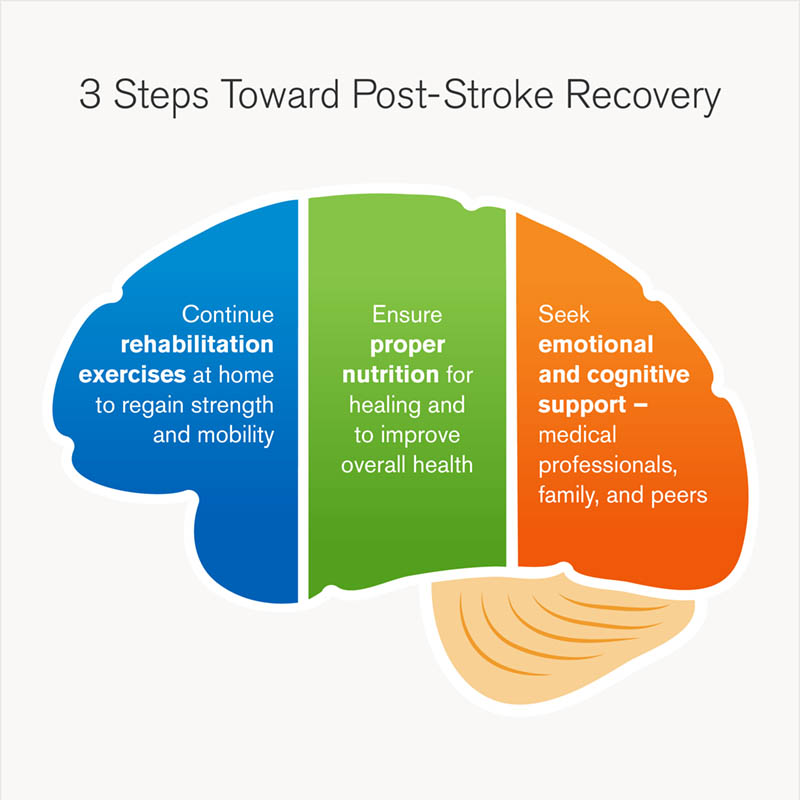Recovering From a Stroke: Essential Care, Conditions and Rehabilitation Practices
May 5, 2024
Categories: Stroke
Stroke recovery is a test of resilience, patience and determination. Survivors often find themselves navigating a new life filled with challenges and uncertainty. Yet it also presents opportunities for rehabilitation and recovery. Surviving a stroke is a formidable challenge, but it's just the first step. What follows is a crucial process of healing, adapting, and regaining strength.

We spoke with Jessica L. Wilson, MD, a neurologist at Loyola Medicine, to learn the fundamentals of post-stroke care and to help patients adopt a proactive approach to stroke rehabilitation.
Stroke rehabilitation exercises you can do at home
Recovering from a stroke demands patience, perseverance, and the right set of exercises tailored to your unique needs. Starting a rehabilitation routine at home can significantly contribute to regaining your strength and mobility. But remember, before beginning any new exercise routine, consult with your health care provider to ensure these exercises are suitable for your specific recovery.
"Stroke rehabilitation exercises are crucial and should not be delayed. Therapy often begins as soon as the patient is medically stabilized, which highlights the importance of continuing rehabilitation exercises at home to complement professional guidance," says Dr. Wilson.
Upper body exercises
After a stroke, regaining arm and shoulder strength is essential for everyday tasks like dressing, eating, and personal care. Start with these two basic exercises:
- Wrist curls: Sit comfortably with your forearm resting on a table, holding a light weight or a small water bottle. Slowly bend your wrist up and down. Aim for 10-15 repetitions, then switch to the other arm. This exercise helps strengthen the wrist muscles and improves grip.
- Shoulder blade squeezes: Sit or stand with your back straight. Gently pull your shoulder blades toward each other, as if trying to hold a pencil between them. Hold for 5 seconds, then release. Repeat 10-15 times. This exercise is excellent for improving posture and shoulder stability.
Lower body exercises
A stroke can affect your sense of balance and impair your ability to walk confidently. Strengthening the legs can improve this. These exercises can be done with or without assistance:
- Seated knee lifts: Sit in a sturdy chair with your feet flat on the ground. Slowly lift one knee toward your chest, then lower it back down. Repeat 10-15 times, then switch legs. This exercise strengthens the thigh muscles and helps with leg control.
- Ankle rotations: This can be done sitting or lying down. Lift one foot off the ground and rotate your ankle in clockwise and then counterclockwise directions. Aim for 10 rotations in each direction, then switch to the other ankle. Ankle rotations improve flexibility and circulation.
Regular practice is the key to making progress. Aim to exercise once a day, completing each exercise for 2 to 3 sets of repetitions as tolerated, but listen to your body and do not overexert yourself. To stay safe, ensure you have a stable surface to hold onto if needed, and consider having a caregiver or family member nearby when you're exercising.
Make sure to also celebrate small improvements. Recovery from a stroke can be a slow process, and every bit of progress is a step in the right direction.

Diet and nutrition after a stroke
Proper nutrition plays a pivotal role in stroke recovery by aiding in the healing process and helping to prevent future strokes. Adjusting your diet can significantly impact your overall health and well-being. For example, antioxidants in fruits and vegetables can help reduce damage to blood vessels.
"Diet plays a pivotal role in not just recovery, but also in preventing future strokes. The health of our blood vessels, pre and post-stroke, relies heavily on our dietary choices. Aiming for a low-fat diet and managing blood pressure are key to supporting vascular health," says Dr. Wilson.
Other essential nutrients include:
- Omega-3 fatty acids: Found in fish like salmon, mackerel, and sardines, omega-3s are vital for brain health and reducing inflammation. Aim for two servings of fatty fish per week.
- Fiber: High-fiber foods, such as whole grains, fruits, and vegetables, promote good digestion and help manage cholesterol levels. Incorporating a variety of colorful fruits and vegetables into your meals ensures a broad spectrum of vitamins and antioxidants.
- Potassium: Foods rich in potassium, like bananas, potatoes, and spinach, can help manage blood pressure, a significant factor in stroke risk. Incorporating these foods into your diet can support vascular health.
To incorporate these nutrients into your diet, focus on:
- Lean proteins: Sources like chicken, turkey, legumes, and tofu support muscle repair and strength. Opt for skinless poultry and plant-based proteins to reduce fat intake.
- Low-fat dairy: Calcium and vitamin D are important for bone health, especially if mobility issues limit sun exposure. Choose low-fat or fat-free dairy options to reduce saturated fat intake.
- Healthy fats: Avocados, nuts, and olive oil are excellent sources of monounsaturated fats, promoting heart health without contributing to cholesterol buildup.
And make sure to limit your intake of these nutrients:
- Saturated and trans fats: Reducing intake of high-fat meats, butter, and processed snacks can lower bad cholesterol levels and improve heart health.
- Excess salt: High sodium intake is linked to increased blood pressure. Limit processed foods and season your meals with herbs and spices instead of salt.
- Sugar: Excessive sugar can lead to weight gain and increase stroke risk. Limit sugary drinks and snacks, opting for natural sugar sources like fruits.
A balanced, nutritious diet can significantly enhance your recovery and help prevent future strokes. By focusing on whole, unprocessed foods and being mindful of your intake of fats, salt, and sugars, you can support your body's healing process and promote long-term health.
Understanding post-stroke conditions
Surviving a stroke can already be a life-changing event, but it's often just the beginning of a long journey toward recovery. Stroke survivors may face a range of post-stroke conditions that affect their physical, cognitive, and emotional well-being. Recognizing and understanding these conditions are crucial steps in the recovery process.
"Stroke survivors might face a myriad of challenges, ranging from physical weaknesses that can evolve into spasticity to cognitive changes such as vascular dementia," says Dr. Wilson.
For example, some conditions that affect your physical ability include:
- Hemiparesis (weakness on one side): Many stroke survivors experience weakness or paralysis on one side of their body. Regular physical therapy and exercises can help regain strength and improve coordination.
- Spasticity (muscle stiffness): This condition causes muscles on the affected side to remain contracted, leading to stiffness and difficulty moving. Stretching exercises, physical therapy, and sometimes medications can help manage spasticity.
- Fatigue: Post-stroke fatigue is common and can significantly impact daily activities. Managing energy levels by pacing activities throughout the day, ensuring adequate rest, and improving sleep quality are vital coping strategies.
Patients recovering from a stroke can also experience conditions that affect their cognitive ability and emotional state.
- Memory loss and cognitive impairments: Stroke survivors may experience difficulties with memory, attention, and problem-solving. Cognitive rehabilitation exercises, such as memory games, puzzles, and tasks that require focused attention, can aid in recovery.
- Aphasia (language impairment): Difficulty in speaking, understanding speech, reading, or writing can occur. Speech and language therapy can greatly improve communication skills and enhance quality of life.
- Depression and anxiety: It's not uncommon for stroke survivors to experience depression or anxiety due to the sudden life changes and challenges post-stroke. Seeking support from mental health professionals, joining support groups, and sometimes medication can provide relief.
- Post-stroke emotional changes: Some survivors may exhibit sudden emotional changes, such as crying or laughing without apparent reason. Understanding and support from family, friends, and caregivers are crucial, along with professional guidance.
To help manage these conditions, seek professional help. Early intervention from a multidisciplinary team including neurologists, physiotherapists, occupational therapists, and speech therapists can tailor a stroke rehabilitation plan best suited to your needs. Building a support network can also be extremely helpful. Connecting with others going through similar experiences can provide emotional support, practical advice, and encouragement.
"The transition to a new lifestyle, experiencing loss of functions, or recognizing that one is different from their baseline can be incredibly challenging. Mental health specialists play a critical role in providing the understanding and support needed during this difficult time," says Dr. Wilson.
Dr. Wilson is an Illinois native who is fellowship trained in clinical neurophysiology with additional certification in epilepsy. With family members who suffer from neurological conditions, she has personally witnessed the impact that such conditions can have on someone's life. Dr. Wilson sees patients for a variety of neurological and cognitive concerns, including post-stroke recovery and care.
Book an appointment today to see Dr. Wilson by self-scheduling an in-person or virtual appointment using myLoyola.
